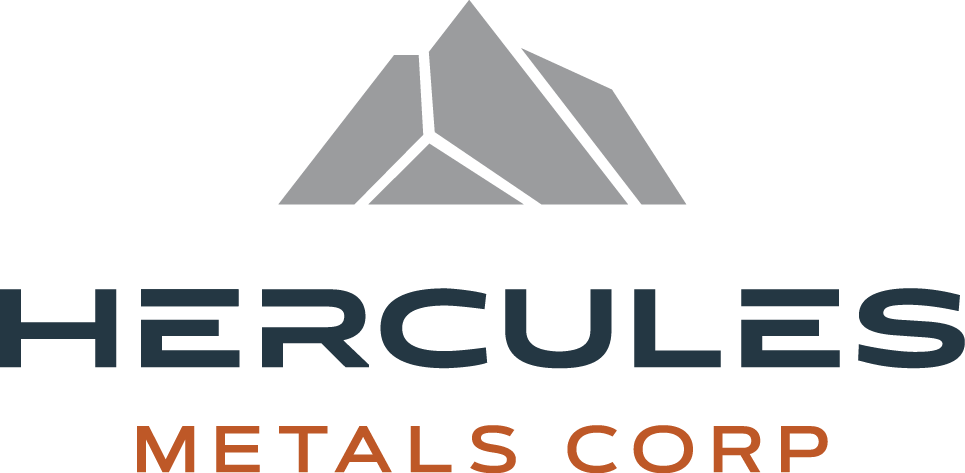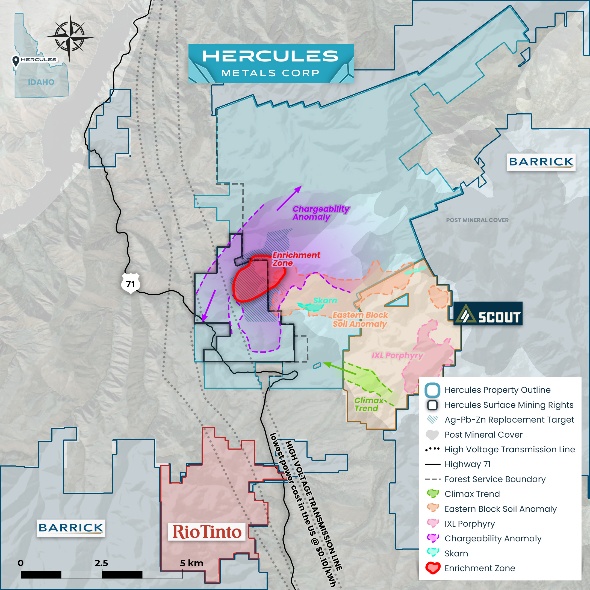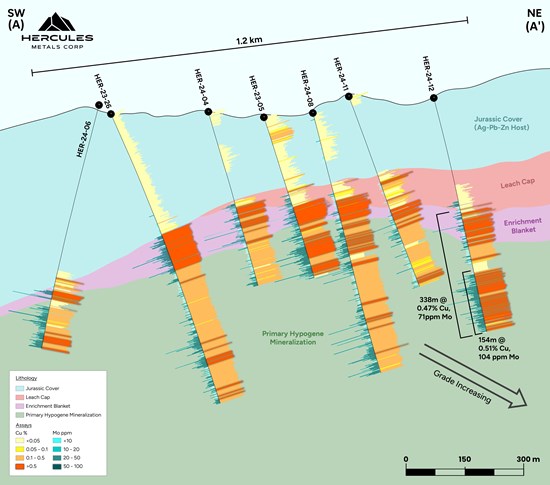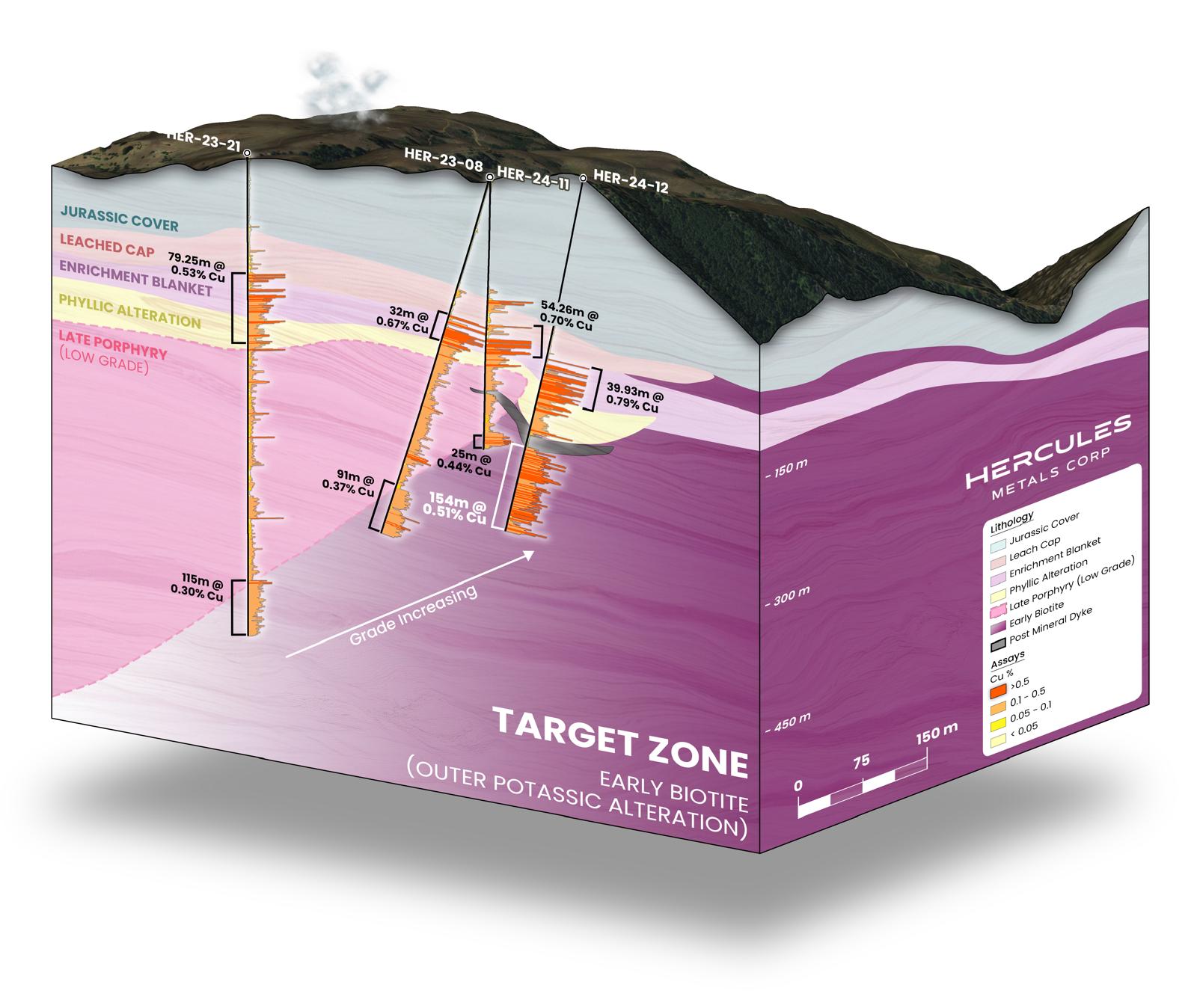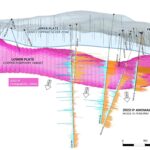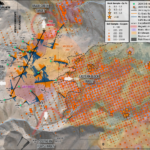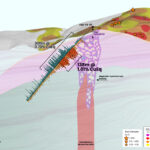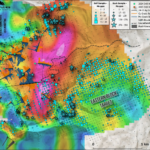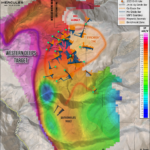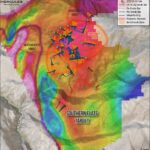Our Flagship
The Hercules Project
Hercules Project
Overview
Before the discovery of porphyry copper in 2023, Hercules was primarily a silver project. The district had been mined and explored for high grade silver since the 1800s, with the most extensive drilling activity happening between 1965 and 1988. At that time, hundreds of shallow holes were drilled, targeting widespread silver mineralization within a specific host rock known as the Hercules Rhyolite. The Hercules Rhyolite can be traced for over 70km south-southwest into Oregon, but a younger volcanic event around 16 Ma covered more than 95% of the rhyolite, presenting significant challenges for exploration at the time.
The Company purchased 100% of the Hercules project in 2021 and began using modern systematic exploration to look deeper than ever before. That approach led to a major porphyry copper discovery in 2023 which has shifted the project’s focus dramatically. The initial discovery was made at depth, below strong silver mineralization on the west side of the Property. Additional drilling has now demonstrated mineralization to occur at progressively shallower depths toward the east, where the overlying cover eventually pinches out entirely, exposing a large, untested copper, molybdenum and gold soil anomaly which spans for kilometers in distance.
Recent drilling in HER-24-20 has discovered the shallowest mineralization to date, with just 72m of leach cap and Jurassic cover. Further east, the Jurassic cover is fully eroded and only the leach cap remains, presenting a unique and compelling shallow exploration target, where Hercules aims to unlock the most significant value yet in its 2025 drilling campaign.
Idaho was ranked 20th in the world for investment attractiveness, based on mineral endowments and public policy factors such as mining regulation, taxation and political support.
Fraser Institute’s Annual
Survey of Mining Companies,
2023
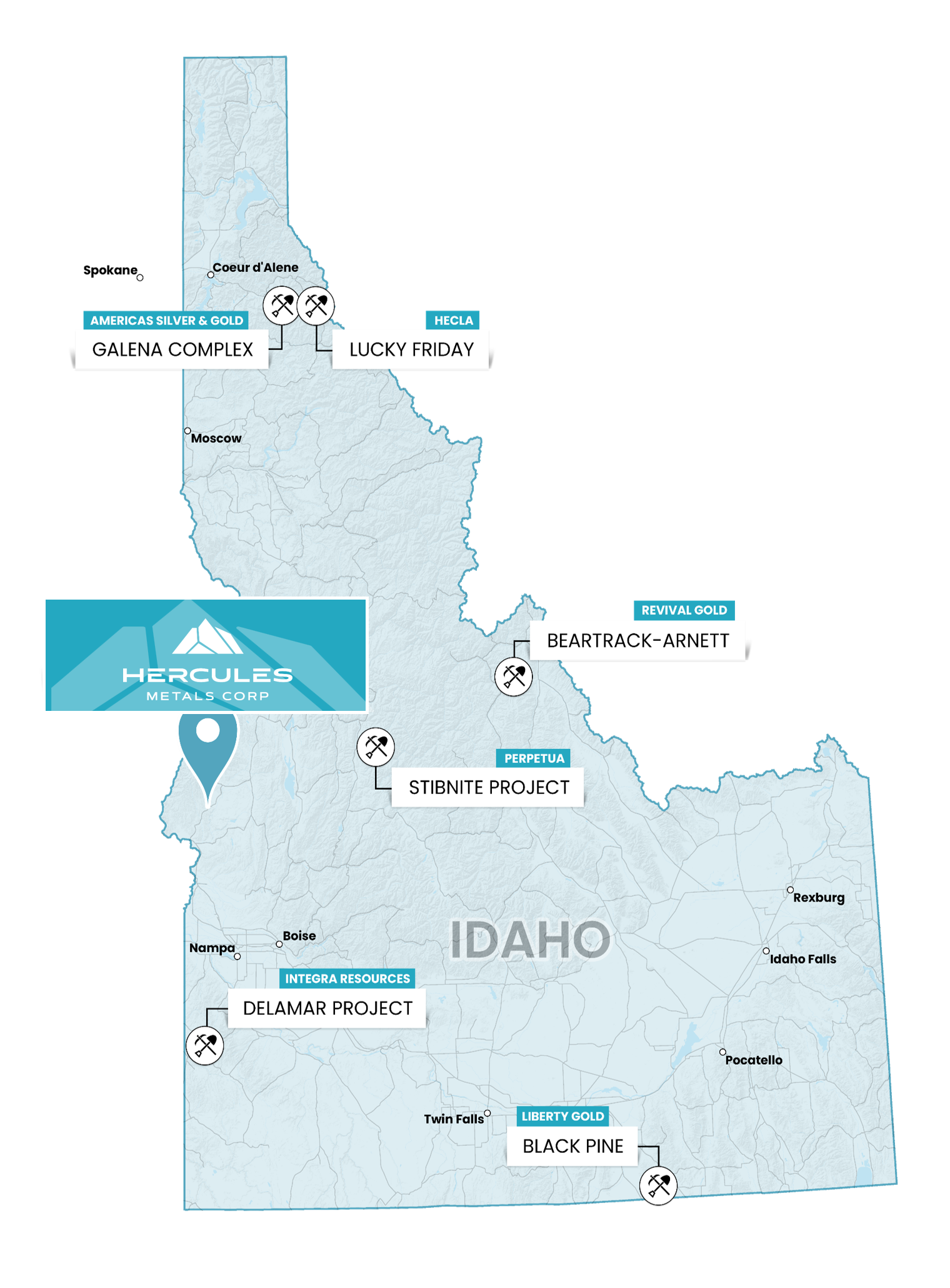
Highlights
Ownership
The Project is located mostly on Idaho state land with grandfathered exploration, mining and milling rights. The Company’s U.S. subsidiary, Anglo-Bomarc, U.S., Inc. was deeded the right to use the surface for mining over the discovery area, originating from a 1965 option agreement. The Project is subject to a 2% NSR, half of which is buyable for CAD $1M.
Geology
Series of stacked thrust sheets emplaced rhyolite-hosted silver
(+/-lead-zinc) mineralization directly above a large blind porphyry copper
system.
Discovery drilling in 2023 located large zones of porphyry style alteration at
depth, which is inferred to have a similar strike length to the overlying
silver mineralization; approximately 5.5 kilometers.
Extensive Exploration History
28,000 meters of historical drilling (>300 holes from 1965-1988),
defined several continuous zones of silver mineralization with average depths
of less than 90 meters.
Prior to Hercules Metals, the Project had never seen a modern, systematic
exploration program.
Methodical Exploration
2022: ~7,000 meters of drilling completed in 35 drill holes across the Property.
2023: ~12,000 meters of drilling completed in over 20 drill holes to expand the system.
Current
Exploration
The summer 2024 Phase III program consisted of over 12,000m of drilling, starting west of the 2023 discovery area, and testing new magnetic anomalies and conductivity and chargeability anomalies identified by the 2023 deep-seeking 3D IP survey.
- The phase III drill program focused on multiple targets focusing on the Leviathan porphyry coper system, including:
- Large step-out drilling defined a 1.2km x 1.6km mineralized zone with potential for multiple porphyry centers
- Shallow Porphyry Mineralization to the Southeast: Recent drilling has intersected early biotite alteration with mineralization beginning as shallow as 72 meters true depth, indicating potential for near-surface porphyry mineralization.
- Grade Creek ZoneIncreasing Grades to the North with first recorded increase in mineralization at depth, outside of the late Porphyry, where a large untested chargeability and magnetic anomaly presents a compelling target for a vertically extensive early porphyry center.
- New Hydrothermal Breccia: The discovery of a magmatic-hydrothermal breccia pipe represents a new target type with vertically extensive potential.
- Multiple untested chargeability targets remain with only 20% of the target area tested to date with the system remaining open in all directions – 6 multi-km scale targets identified for further drilling.
- Metallurgical Testing: Initial metallurgical testing confirmed that the mineralized material from the Leviathan porphyry copper system is amenable to conventional processing techniques, with copper recoveries exceeding ± 87% using standard flotation methods, with ongoing locked cycle testing now projected to recover ± 90%. Additionally, A straightforward two-step leaching process on the near-surface silver delivered impressive recoveries of 86% for oxide mineralization and 82% for sulfide mineralization.
The 2023 property-wide deep-seeking IP survey was designed to explore the new Leviathan Porphyry at depth. The new survey expanded on the initial chargeability anomaly first tested last year and revealed trends that are comparable with known porphyry copper systems.
The deep-seeking 3D IP, direct current resistivity and drone magnetic geophysics over the area to be drill tested in 2024, revealed multiple prospective targets, coincident with the direction of increasing copper porphyry grades seen in the initial 2023 deep discovery holes drilled at the Leviathan Porphyry.
- Conductivity anomaly below historical mining at the Belmont Zone
- Kilometers of prospective chargeability from Belmont to Grade Creek
- Moderate chargeability anomaly near surface at the Big Cut Skarn provides an additional satellite drill target
- 3D magnetic inversion reveals magnetic highs potentially associated with a potassic core.
- Soil sampling, mapping, and prospecting planned to cover extensions of newly identified geophysical targets
The summer 2023 Phase II drill program consisted of step-out holes designed to test for extensions of historical mineralization, verify previous historical drilling and test a series of new targets generated by greenfields exploration.
The 6,000 m program focused on the following targets:
- Hercules Adit and Frogpond Zones: Step-out holes aiming to extend mineralization, as well as infill and further verify historical drilling results.
- Hercules Rhyolite: Robust silver targets identified through surface mapping, geophysics and geochemistry, including at the Hinge, Haystack and Belmont Zones.
- New porphyry copper-silver (+/- gold) target: Interpreted as the center of a large zoned system and feeder for the surrounding silver (+/-lead-zinc) hosted in the Hercules Rhyolite.
- Large-scale untested chargeability anomaly at depth, potentially representing a large body of strong sulfide mineralization.
Five deep drill holes encountered strong phyllic alteration, which is typical of the margins of a porphyry system, over approximately 450m x 500m, called the Leviathan Porphyry. HER-23-05, the first hole to test a large-scale (>1.8km) blind chargeability anomaly, intersected 185.29m of 0.84% Cu and 111 ppm Mo from 246m to 431.2m, including 45.33m of 1.94% Cu.
Additional step-out holes drilled at various orientations to the southeast of HER-23-05, where chargeability data was currently available, intersected similar alteration, veining and copper mineralization over variable lengths. Many directions remain to be tested, and the potassic center, which often carries the highest grades within porphyry systems, remains to be found.
The 2022 3D IP survey over the Hercules Adit, Frogpond and Belmont Zones, identified a large untested chargeability anomaly at depth. The results demonstrated the excellent exploration potential at Hercules and contributed to 2023 drilling.
- Strong chargeability values (>25ms), below historical drilling, and over a continuous strike length of 1.8 kilometers
- Anomaly is coincident with the untested base of the Hercules Rhyolite where surface mapping indicates the strongest silver mineralization to occur (See Oct 18 NR)
- Lower portion of anomaly lies down dip of the copper mineralization hosted within the underlying Seven Devils volcanics
- Anomaly remains open up-dip to the southeast
The November 2022 Phase I drill program was designed to test and verify historical drilling assays as well as gain the geological and geotechnical information needed to support a Phase II drilling campaign in early spring of 2023.
The program consisted of infill and step-out holes at the Frogpond and Hercules Adit Zones with additional step-out holes to test open zones with little to no prior drilling.
A total of 1,995 feet in 9 drill holes was completed, with several holes bottoming in mineralization, and high-priority areas were tested within the Frogpond and Hercules Adit Zones for potential inclusion in future resource estimates. (See Feb 28 NR).
Highlights of the program include:
- Strong grade over multiple significant intervals, including drill hole HER-22-01, the first hole of the program, which intercepted 38 meters of 353 g/t Ag, 0.64% Pb, 2.28% Zn and 0.16% Cu (487 g/t AgEq), beginning at a shallow depth of 26 m depth in first drill hole, HER-22-01.
- HER-22-01 included a higher-grade intercept of 4.57 m grading 791 g/t Ag, 1.25% Pb, 4.06% Zn and 0.18% Cu (1,021 g/t AgEq) starting at 29 m.
- HER-22-07 intersected 44.2 m grading 224 g/t Ag, 0.32% Pb, 0.38% Zn and 0.09% Cu (258 g/t AgEq) starting at 1.5 m.
- Drilling grades significantly exceed grades sampled at surface, supporting the concept of potential supergene enrichment of mineralization below surface.
- Confirmed the presence of a high-grade shoot (the P-19 Shoot) at the east end of the Frogpond Zone; open at depth to the east.
- Confirmed the presence of shallow, high-grade mineralization at Frogpond and Hercules Adit Zones, with additional follow-up planned for Phase II.
Current
Drilling
Significant intercepts in the Leviathan System include:
Hole ID | From (m) | To (m) | Interval (m) | Cu (%) | Ag (g/t) | Mo (ppm) |
HER-23-05 | 246 | 431.29 | 185.29 | 0.84 | 2.6 | 111 |
including | 246 | 291.33 | 45.33 | 1.94 | 8.2 | 104 |
HER-23-26 | 338.85 | 799.61 | 460.76 | 0.4 | 1 | 74 |
including | 338.85 | 438.91 | 100.06 | 0.76 | 0.7 | 113 |
HER-24-08 | 242.32 | 721.77 | 479.55 | 0.47 | 0.67 | 82 |
including | 242.32 | 388.62 | 146.3 | 0.84 | 0.77 | 61 |
including | 242.32 | 296.88 | 54.56 | 1.47 | 0.95 | 39 |
HER-24-12 | 306.48 | 644.35 | 337.87 | 0.47 | 1.55 | 71 |
including | 325.68 | 365.61 | 39.93 | 0.79 | 0.97 | 65 |
including | 306.48 | 451.71 | 145.23 | 0.53 | 2.24 | 49 |
including | 490.73 | 644.35 | 153.62 | 0.51 | 1.12 | 104 |
Long-section A – A’ showing increase in primary hypogene grade below enrichment blanket in HER-24-12.
Cross-section B – B’ showing the orientation of the late porphyry intrusion and the strong contrast that copper grade has in the surrounding rock. Outside of the late porphyry, biotite altered wallrock is well mineralized, and increasing in intensity to the north. 24-12 has intersected the strongest primary hypogene grades outside of the enrichment blanket thus far.
